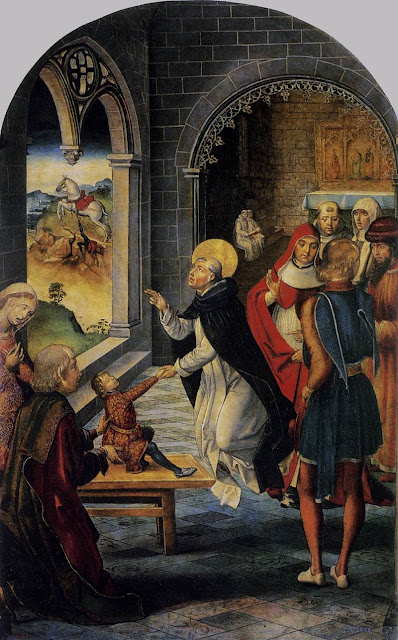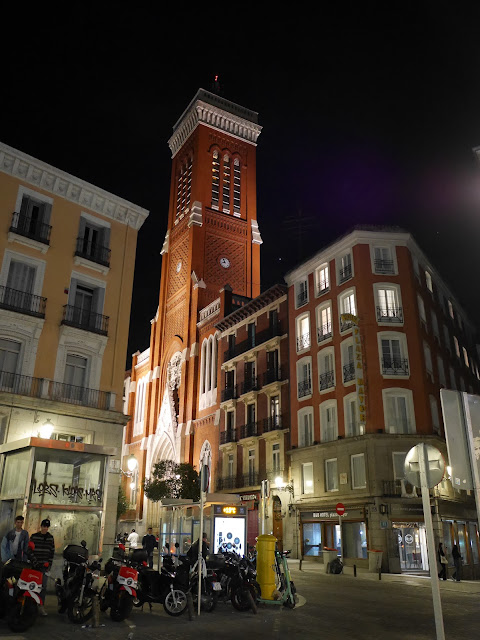El Prado
We have the wife of Ferdinand VII, Maria Isabella, to thank for turning El Prado into one of the world's great painting-and-sculpture museums. The king wasn't curious about art and was content to leave it as a natural-sciences museum and botanical gardens. And we have the Bonapartes to thank for plundering some of its works from monasteries, churches and autocratic palaces ― the same blueprint that played out in Amsterdam, Berlin and Milan a scant 200 years ago.
Photography isn't permitted, so I will have to use my words. Some things that caught my eye:
• The Hieronymous Bosch room (the Dutch painter is known here as "El Bosco." His densely enigmatic "Garden of Earthy Delights" triptych with its curlicued complexities is on display, but what really captured my attention was his very small "The Extraction of the Stone of Madness" ― widely viewed as a critique of medical charlatans. These and other artworks I saw today seemed punishingly close to the otiose arguments currently raging over the pandemic ― purported remedies, the embrace of the fantastical, the allure of superstition. "Plandemia" graffiti is visible from my window. We are cavemen still, gazing into the fire and looking for patterns.
• In the main gallery upstairs, which was barricaded with sandbags and cement slabs during aerial bombardments in the 1930s civil war, oversized works by Titian (called Tiziano here) and Rubens soar radiantly above our heads. Rubens had no better patron than Spain's Philip IV, who commissioned dozens of his works including "The Judgment of Paris" and "The Three Graces," instantly recognizable to anyone who looks them up. El Prado has the most extensive collection of Rubens' works. A serene "Marie de Medici" by Rubens shows the beruffled French queen with pearls, a clamshell collar (and thumb ring) in front of an unfinished background.
• Off the main hallway a vestibule contains strong vertical paintings from El Greco's late period, his broken brushstrokes forming distorted faces bathed in a ghostly light. Next door are Crespis and Caravaggios and a number of Poussin landscapes with mythological mashups that contrast with the restrained chromatic range and focus of Velazquez's "The Feast of Bacchus."
• Bruegel the Elder's unvarnished "The Feast of St. Martin's Day," heavily restored but still washed out and not recognized as legitimate until a decade ago, depicts a hundred impoverished townsfolk extending whatever containers they have ― shoes, hats ― to collect wine from a giant barrel during that November celebration.
• The underappreciated Alonso Cano continues to shock and embarrass modern audiences with his "St. Bernard and the Virgin." Nearby, fruit and flower arrangements painted by Juan de Arellano, Bartolome Perez and Juan de Espinosa are helpfully grouped.
• In a couple of early Renaissance stunners, Pedro Berruguete depicts St. Dominic ― already levitating! ― bringing back to life a man killed in a horse-riding accident. The deceased gets a second chance at childhood in the aptly titled "St. Dominic Resurrects a Boy." In the second, an anonymous artist shows us a hungry mule refusing to eat from a basket of barley because it contains a wafer representing a consecrated host in "The Miracle of Saint Anthony of Padua."
For many of our neighbors in 2021, rational evidence is still up for debate. Another trip or two to El Prado are in order. There may be no better place to meditate on our species' ever-changing song with the same lyrics.
 |
"St. Dominic Resurrects a Boy" by Pedro Berruguete. |
 |
"Miracle of St. Anthony of Padua," anonymous. |
 |
| Bosch's "The Extraction of the Stone of Madness." The top line reads: "Master, rid me of this stone soon." The bottom line: "My name is Lubbert Das." |

